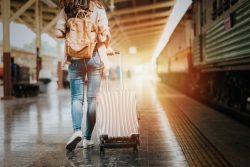Tips for Traveling with Sleep Apnea
November 4, 2021
Traveling when you have sleep apnea can be a task—dragging a bulky CPAP machine through airport security, trying to take a power nap while on the plane without using it, and getting it to plug into the worn-out electrical outlets in your hotel room. P While business trips or vacations are a time to “get away” from everyday life, you can’t get away from your everyday routine, especially your health routines and that includes your sleep apnea treatment.. Traveling with sleep apnea isn’t always easy, especially when you rely on a CPAP to help you sleep. We’ve compiled a few suggestions below to help you protect your precious sleep while away from home.
Keep Up with Your Treatment
Packing a CPAP
If you use a CPAP machine, you shouldn’t have problems taking it with you on your flight, but be sure to check your airline’s guidelines before you start packing. It is recommended to bring a letter from your doctor explaining that your device is medically necessary to avoid getting flagged at the security checkpoint. It is likely that your CPAP will be inspected, so it’s only an issue if you are running late for your flight (envision the McCallister family from Home Alone). If you’re toting a CPAP, be sure to pack cleaning supplies, an extension cord, and a power adapter (if you are traveling overseas).
A travel-friendly alternative to CPAP
If you are looking to reduce the stress of navigating airport security and travel with a CPAP machine and accompanying accessories, you might be a good candidate for an oral appliance instead to treat your sleep apnea. Oral appliances are similar in size to a mouthguard that you would wear for sports and custom-made to fit your needs. They are a convenient and highly portable sleep apnea treatment that has proven effective for mild to severe cases.
e
Bring Your Pillow (or any other comfort items)
Unless you are staying at a mainstream hotel that is pretty consistent with the pillows they provide, you might have no idea what to expect when you get to your room. Bringing your own pillow (or a travel pillow or other comfort item) can enable you to sleep in a comfortable and consistent position that minimizes any away-from-home anxiety and help you get better sleep. Reducing the number of variations in your sleep routine is always a good thing, so if you can squeeze in your go-to pillow, it’s worth it.
Don’t Overexert Yourself
It’s important to maintain a balance of activity and rest, especially while traveling. Wearing yourself out to exhaustion can worsen symptoms of sleep apnea. Try to schedule enough time during your trip that you will have some opportunities to relax. Depending on health and personal limits, it’s wise to leave a few mornings or afternoons without any scheduled activities, or even one or more entire days open for some good old-fashioned relaxation.
Manage Timezone Fatigue
Along those same lines, keep in mind the importance of resting if you will be traveling more than a few time zones away. Jet lag is real and can seriously interfere with your body’s circadian rhythm! Leaving a bit of open time in your schedule when you are traveling to and from your destination can give you the opportunity to adjust and get an adequate amount of rest.
Traveling with obstructive sleep apnea doesn’t have to be a burden! The tips shared above can help you enjoy a productive, enjoyable, and most of all, a restful trip.
Meet the Practice
Dr. Kenneth Mogell is a dental sleep medicine expert who specializes in helping patients conquer sleep apnea via oral appliance therapy. He has decades of experience and has gained a reputation for being a leader in his field. To learn more about him and how he may be able to help you start getting the sleep you need, contact our office at 321-265-3462. We accept Medicare, Tricare, and most medical insurance!
